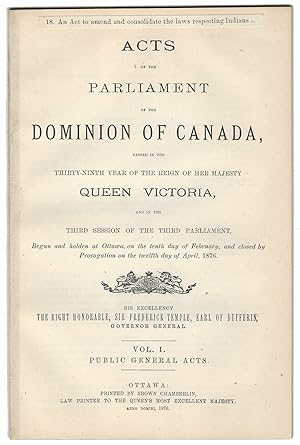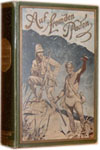INDIAN ACT (1876). An Act to amend and consolidate the laws respecting Indians.
FIRST NATIONS. FIRST INDIAN ACT. Canada. Parliament.
Verkäufer
Bob Gaba, Victoria, BC, Kanada
Verkäuferbewertung 5 von 5 Sternen
![]()
AbeBooks-Verkäufer seit 10. Juni 2020
Beschreibung
Beschreibung:
Octavo (9.25 inches). 39 Victoria, Chapter 18 (Statutes of Canada). General title leaf with Royal coat of arms; caption title, pages 43-73, with an index for the Act affixed to the verso of the last text leaf. Neatly extracted from a bound volume and expertly mended. The Indian Act, 1876 was the most important and influential legislation governing First Nations within the Dominion of Canada during the period following Confederation. It was designed by the federal government to administer Indian status, local First nations governments and management of reserve land and communal monies. The Act consolidated previous legislation concerning First Nations Peoples (including the Gradual Civilization Act, 1857) and adopted an explicit vision of assimilation in which Indians were encouraged to dispense with their ethnic status and traditional culture to become Canadian citizens. The ultimate intent of the assimilation policy was to absorb all Aboriginal peoples into white Euro-Canadian society. The Act was comprehensive, and contained one hundred Sections that touched on all aspects of Indian life. Under the Act, the interpretation of the term Indian placed stronger emphasis on male lineage in its definition of Indian status, and denied Indian status to the Metis of Manitoba because of their mixed Indian and European heritage. The system of enfranchisement (being the loss of Indian status, either voluntarily by application or involuntarily by marriage to non-Indians) was continued and broadened to impose compulsory enfranchisement for Indians that received a university degree, or who became a doctor, lawyer, or clergyman. The system of limited self-government (in which elected chiefs and Band councils served for three years) continued, as did the power of the Superintendent of Indian Affairs to impose democratic systems (whether desired by the Band members of not) and to order that reserve lands be divided into lots for Band members as a means of encouraging individual ownership of property. The Act also included many protective features, such as: severe restrictions on intoxicants and related punishments for infractions, exclusive use of reserve lands by Band members (unless otherwise specified by special license), continued exemption from provincial and federal taxes on real estate and personal property on reserves, and protection of Indian land and property from seizure for debt. There were also rules for the management and sale of minerals and timber rights, and procedures for the disposition of Indian moneys. Overall, the government continued to maintain control over Indian lands, and dictated who could purchase land, the terms of sale, and the price paid for surrenders. Interestingly, the Act made no mention of Treaties that were already in existence or in negotiation. Bestandsnummer des Verkäufers 073
Bibliografische Details
Titel: INDIAN ACT (1876). An Act to amend and ...
Verlag: Ottawa: Brown Chamberlin
Erscheinungsdatum: 1876
Einband: Soft cover
Zustand: Very Good
Auflage: 1st Edition
AbeBooks ist ein Internet-Marktplatz für neue, gebrauchte, antiquarische und vergriffene Bücher. Bei uns finden Sie Tausende professioneller Buchhändler weltweit und Millionen Bücher. Einkaufen bei AbeBooks ist einfach und zu 100% sicher — Suchen Sie nach Ihrem Buch, erwerben Sie es über unsere sichere Kaufabwicklung und erhalten Sie Ihr Buch direkt vom Händler.
Millionen neuer und gebrauchter Bücher bei tausenden Anbietern
Neue und gebrauchte Bücher
Neue und gebrauchte Exemplare von Neuerscheinungen, Bestsellern und preisgekrönten Büchern. Eine riesige Auswahl an günstigen Büchern.
Antiquarische Bücher
Von seltenen Erstausgaben bis hin zu begehrten signierten Ausgaben ? bei AbeBooks finden Sie eine große Anzahl seltener, wertvoller Bücher und Sammlerstücke.
Versandkostenfreie Bücher
Hier finden Sie viele hunderttausend neue, gebrauchte und antiquarische Bücher, die Ihnen unsere deutschen und internationalen Händler versandkostenfrei liefern.





